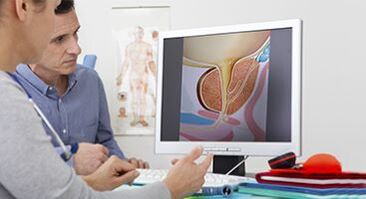Prostatitis and prostate adenoma are diseases that are often diagnosed in men.It is not surprising that the representatives of the stronger sex are interested in their symptoms and other characteristics.Let's find out how these pathologies differ and how they are treated.

Prostatitis and prostate adenoma are diseases that are often diagnosed in men.
What is the difference between prostate adenoma and prostatitis?
There are actually quite a few differences.
They are related to the following factors:
- Time of onset of the disease.Usually, prostate adenoma is diagnosed in men aged 45-50 years, and prostatitis also affects younger representatives of the stronger sex.
- First symptoms.As a rule, with prostatitis, patients complain of unpleasant sensations (including quite severe pain), and with adenoma - of urination disorders.
- Reasons.Prostatitis is an inflammatory process and can be provoked by infections of the genital tract, and prostate adenoma is a growth of tissue due to various factors.
- Clinical picture.Acute prostatitis is often accompanied by chills and fever, and adenoma occurs without signs of infection.
- The nature of pain.The inflammation is characterized by sharp pain in the groin, perineum and rectum.The tumor in the early stages may not manifest itself in any way.Even if there is pain, it is minor.
Both pathologies are characterized by impaired sexual function.
Reasons for the development of prostatitis

The disease develops mainly under the influence of microorganisms that penetrate the prostate gland from various sources.As a rule, prostatitis occurs against the background of sexually transmitted infections.
The disease develops mainly under the influence of microorganisms that penetrate the prostate gland from various sources.
Some experts classify congestive prostatitis in a separate group.This disease is provoked by poor blood circulation in the pelvis.Against this background, inflammation occurs.The infection occurs quite quickly.As a result, stagnant prostatitis becomes chronic.
Symptoms of the disease
Prostatitis can occur in two forms: acute and chronic.

Not in all cases, acute prostatitis occurs with pronounced symptoms.Some men report only a general malaise, mild pain and a temporary weakening of sexual function.
The acute form is characterized by the following symptoms:
- pain in the perineum;
- feeling of pain under the scrotum;
- increased body temperature;
- pain during defecation;
- increased frequency of urination;
- frequent painful urge to urinate;
- Erection disorders.
Patients also complain of purulent and mucous discharge from the urethra, shooting pain in the perineum and groin, overstimulation and painful ejaculation.
important!Not in all cases, acute prostatitis occurs with pronounced symptoms.Some men report only a general malaise, mild pain and a temporary weakening of sexual function.These symptoms of a slow form of prostatitis resemble prostate adenoma, which can lead to errors in diagnosis.
Chronic pathology is characterized by 3 main groups of symptoms:
- Painful.Men complain of pain in the rectum and lower back, shooting, tingling and "pins and needles" in the groin, thighs, perineum and back.Against this background, the patient may become nervous.Men also report bouts of sweating and chills.
- Urinary dysfunction.Men complain of a slow stream of urine, difficulty emptying the bladder and frequent urges to go to the toilet.
- Sexual dysfunction.Patients note a decrease in libido, lack of ejaculation or premature ejaculation, and difficulty with a full erection.Infertility often occurs due to prostatitis.

Pelvic nerves are often involved in the pathological process.As a result, additional symptoms are added to the main symptoms of prostatitis.These consist of hot flashes and fever in the evening, tachycardia, as well as mood swings and problems with concentration.Some men complain of fatigue and sleepiness during the day, suspiciousness, a feeling of a lump in the throat, increased salivation, weight gain (without changes in diet and physical activity).
The cause of benign growth of glandular tissue is a change in the metabolism of testosterone in the cells.
Causes of prostate adenoma development
The cause of benign growth of glandular tissue is a change in the metabolism of testosterone in the cells.This process is inevitable and begins in men at about 40-45 years of age.Therefore, each representative of the stronger sex to one degree or another faces signs of pathology.Usually, a benign tumor has no pronounced symptoms at the first stage, but is diagnosed already at stage 2 or 3.
Symptoms of proliferation of glandular tissue
The difference between prostatitis and prostate adenoma is in the main symptom.With a benign tumor, urination disorders always come to the fore.

The difference between prostatitis and prostate adenoma is in the main symptom.With a benign tumor, urination disorders always come to the fore.
They are usually divided into 2 groups:
- Irritating signs.Patients complain of an increased urge to urinate, the need to empty the bladder regularly at night, and urinary incontinence.
- Obstructive signs.They are the result of a narrowing of the urethra due to enlargement of the gland.They are expressed in a strained need to urinate, a weak stream of urine and dribbling.
With the development of the disease, the kidneys, ureters and pelvis are involved in the pathological process.This leads to an increase in blood pressure, pain in the lower back, constant thirst, itchy skin, weakness and general deterioration of well-being.Patients develop pathologies of the cardiovascular system.Men also complain of suppressed sexual function.Infectious complications of prostate adenoma are also detected.In some cases, stones form in the bladder.Signs of varicose veins (if present) may also worsen.
Principles of treatment of prostatitis and prostate adenoma
The therapy of the disease is carried out with the help of different groups of drugs.
Treatment of prostatitis is aimed at:
- suppression of the inflammatory process;
- stopping the active reproduction of bacteria;
- improvement of lymphatic drainage and blood circulation in the pelvic veins;
- preventing the chronification of the pathological process.
For these purposes, patients are prescribed anti-inflammatory and antibacterial drugs, as well as venotonics and blood thinners.Enzyme agents and immune response stimulants are recommended.
Treatment of prostate adenoma is aimed at:
- volume reduction;
- restoration of normal urination.
To solve these problems, patients are prescribed alpha-blockers, 5-alpha reductase inhibitors, herbal medicines and other drugs.

Both prostatitis and prostate adenoma may require restoration of potency.For this purpose, combined preparations based on plant components and other components are prescribed.Medicines can be used simultaneously with the treatment of the main pathologies.If taken correctly, they do not harm the body.
important!All medicines are exclusively prescribed by a doctor.Self-medication is strictly prohibited.It can change the clinical picture and lead to diagnostic difficulties.In addition, self-prescription of drugs can lead to deterioration of well-being.You should also not stop the medication yourself!
In some cases, diseases are treated surgically.It is prescribed when conservative therapy is ineffective or inappropriate for one reason or another.
As a rule, surgical interventions are appropriate at stages 2-3 of prostate adenoma.
The main operations include:
- TUR (transurethral resection);
- laser treatment;
- laparoscopy;
- interventions using the da Vinci robot.
All operations are minimally invasive.They reduce damage to healthy tissue and provide a short rehabilitation period.

The operative technique is chosen by the doctor based on the available indications, the accompanying diseases of the patient and his individual characteristics.
Successful treatment of prostate adenoma and prostatitis also includes:
- Refusal of bad habits (smoking and alcohol abuse);
- Exclusion of animal fats, as well as canned, smoked and fried foods;
- Dietary restriction of simple carbohydrates;
- Intake of a sufficient amount of liquid in the body (at least 2 liters of water);
- Regular visits to your doctor.You should contact him even if there are no signs of pathology.This will allow timely identification of all changes and prevent the development of complications.
The benefits of visiting the clinic
- Experienced doctors.Our specialists have been engaged in the diagnosis and treatment of prostate pathologies for a long time.They have the necessary knowledge and skills to perform a wide range of manipulations.
- Ability to quickly diagnose.Our specialists use expert-class equipment.It allows you to make a diagnosis on the day of treatment.
- Individual approach to therapy.The treatment of prostatitis and prostate adenoma is carried out taking into account the type and stage of the disease, the characteristics of the patient, as well as existing concomitant diseases.
- Conservative therapy using modern techniques.
- Modern methods of surgical treatment.Operative interventions are performed using a laser and Da Vinci robot.Laparoscopic operations and TUR (transurethral resection) are performed.This allows you to reduce the risks of interventions and the length of the rehabilitation period.
- Convenience when visiting clinics.They are located near the metro.In addition, we have made sure that there are no queues and that we are ready to receive patients at a time convenient for them.



















